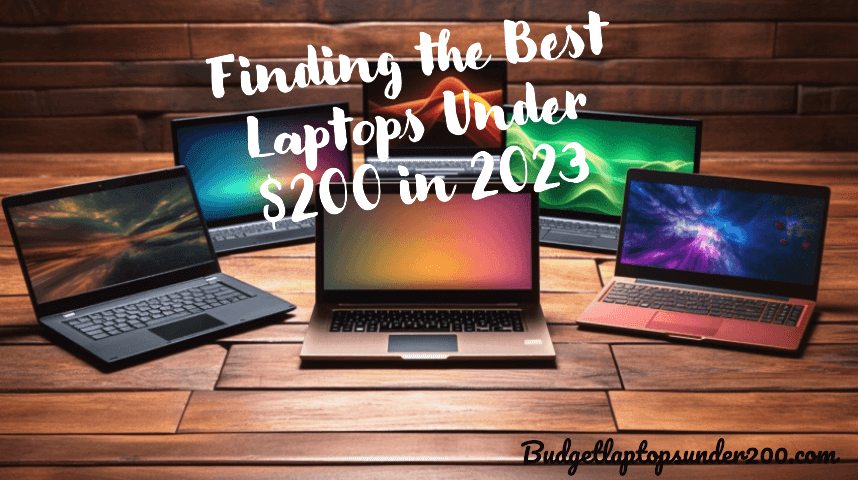Ultimate Buying Guide: Finding the Best Laptops Under $200 in 2023

Table of Contents
In today’s digital age, having a laptop is almost as essential as having a smartphone. However, not everyone can afford high-end laptops with hefty price tags. That’s where budget laptops come in. These affordable devices offer a balance between performance and cost, making digital accessibility possible for everyone. This guide is designed to help you navigate the world of budget laptops and find the best laptops under $200. Whether you’re a student, a professional, or a casual user, this guide will help you understand what to look for in a budget laptop and how to get the most value for your money.
Understand Your Needs:
Before you start shopping, it’s crucial to understand what you need from a laptop. Are you a student who needs a laptop for online classes and assignments? Are you a professional who needs a secondary laptop for travel? Or are you a casual user who needs a laptop for browsing the web, checking emails, and streaming content? Identifying your needs will help you choose a laptop that offers the best value for your money.
For students, a laptop is an essential tool for education. You’ll need a laptop that can handle productivity apps like Microsoft Office or Google Workspace, video conferencing apps like Zoom or Google Meet, and web browsing for research.
For professionals, a secondary laptop can be a handy tool for travel or commuting. You’ll need a laptop that’s lightweight, has a good battery life, and can handle productivity tasks.
For casual users, a laptop is primarily used for entertainment and communication. You’ll need a laptop that can handle web browsing, social media, video streaming, and basic games.
Operating System:
The operating system is the heart of your laptop. It determines how you interact with your device and what applications you can run. In the sub $200 range, you’re most likely going to be looking at laptops running on Google’s Chrome OS. Chrome OS is a lightweight operating system that’s great for basic tasks. It’s also heavily reliant on internet connectivity, making it a good choice for users who primarily use web-based applications.
Chrome OS is designed to be simple and easy to use. It’s based on Google’s Chrome web browser, so if you’re familiar with the browser, you’ll feel right at home with Chrome OS. The operating system is integrated with Google Workspace, so you can easily create, view, and edit documents, spreadsheets, and presentations.
One of the key features of Chrome OS is its fast boot times. Unlike Windows or macOS, Chrome OS doesn’t have a lot of background processes slowing it down, so you can go from a cold start to browsing the web in a few seconds.
However, Chrome OS is not as versatile as Windows or macOS. It can’t run traditional desktop applications, so if you need specific applications for work or school, make sure they have a web or Android app version.
Hardware Specifications:
The hardware specifications of your laptop determine its performance. Here’s what you should focus on:
- Processor (CPU): The processor is the brain of your laptop. It determines how fast your laptop can process information. In the sub $200 range, you’re likely to find laptops with Intel Celeron or AMD A-series processors. These processors are capable of handling basic tasks like web browsing and word processing. However, they’re not suitable for more demanding tasks like video editing or 3D gaming.
- RAM: RAM, or Random Access Memory, is your laptop’s short-term memory. It temporarily stores data that your laptop is currently using for quick access. In the sub $200 range, aim for atleast 4GB of RAM. This allows for decent multitasking, letting you have multiple tabs open in a browser, for example. If you plan on running more demanding web apps or keeping many tabs open at once, you might want to consider a laptop with more RAM.
- Storage: Storage is where your laptop keeps your files and applications. Many budget laptops come with 32GB or 64GB of eMMC storage. Some may offer a 128GB SSD. Keep in mind that Chromebooks also heavily rely on cloud storage, so you’ll need a reliable internet connection. If you plan on storing a lot of files locally, look for a laptop with more storage or consider using an external hard drive or SD card.
Display:
The display of your laptop affects your viewing experience. In the sub $200 range, you’re likely looking at a display resolution of 1366 x 768 pixels. While not HD, it’s acceptable for basic tasks. Also, consider the size of the display. A smaller display (11.6 inches) will be more portable, while a larger one (14-15.6 inches) will provide a better viewing experience.
When choosing a display, consider your typical usage. If you’re primarily reading and writing, a sharper display might not be as important. But if you’re watching videos or viewing photos, you might appreciate a higher resolution display. Also, consider the type of display. Many budget laptops use TN (twisted nematic) displays, which are less expensive but offer poorer viewing angles and color reproduction than IPS (in-plane switching) displays.
Battery Life:
Battery life is especially important if you plan to use your laptop on the go. One of the advantages of budget laptops, especially Chromebooks, is that they often offer excellent battery life. Look for a laptop that offers at least 8 hours of battery life.
When considering battery life, keep in mind that the manufacturer’s estimate is often based on ideal conditions, like the lowest screen brightness and no Wi-Fi usage. In real-world usage, the battery life will likely be shorter. Also, the battery life will decrease over time as the battery naturally degrades.
Connectivity:
Check the number and type of ports included. USB 3.0 ports, an HDMI port, and a microSD or SD card slot can be handy. Also, check if the laptop supports Wi-Fi 5 (802.11ac) or Wi-Fi 6 (802.11ax) for the best wireless connectivity.
In the sub $200 range, you might not get the latest and greatest connectivity options, but you should at least have a few USB ports and a headphone jack. A microSD or SD card slot can be useful for expanding storage or transferring files from a camera.
Wi-Fi connectivity is especially important for Chromebooks, as they rely heavily on internet connectivity. Look for a laptop that supports at least Wi-Fi 5 for a stable and fast internet connection.
Build Quality:
While you can’t expect premium materials in this price range, the laptop should still feel sturdy and well-built. A spill-resistant keyboard is a nice feature to have. Also, consider the laptop’s weight and dimensions, especially if you plan to carry it around often.
When evaluating build quality, pay attention to the hinge, keyboard, and trackpad. The hinge should be sturdy and hold the display in place at any angle. The keyboard should feel comfortable to type on, and the keys shouldn’t wobble or feel loose. The trackpad should be responsive and support multi-touch gestures.
Brand and Reviews:
Consider the brand’s reputation and check user reviews before buying. Brands like Acer, Asus, and Lenovooffer some good options in this price range. User reviews can provide real-world insights into the laptop’s performance and reliability.
When reading user reviews, look for common issues or complaints. If many users are reporting the same problem, it’s likely a legitimate concern. Also, consider the overall rating and the number of reviews. A laptop with a 4-star rating and hundreds of reviews is likely a better choice than a laptop with a 5-star rating but only a few reviews.
Future-Proofing:
While it’s not always possible with a budget laptop, try to get a laptop that’s future-proof. This means it will continue to receive software updates and support for the next few years.
For Chromebooks, Google guarantees at least 6.5 years of software updates from the device’s manufacturing date. This means you’ll get new features and security updates, ensuring your laptop stays safe and up-to-date. However, after this period, your laptop won’t receive any more updates, which could leave it vulnerable to new security threats.
To Conclude:
Choosing a laptop under $200 doesn’t mean you have to compromise on quality. By understanding your needs and knowing what to look for, you can find a laptop that offers great value for your money. Remember, the best laptop for you is the one that fits your specific needs and budget.
Whether you’re a student looking for a laptop for online learning, a professional needing a secondary laptop for travel, or a casual user wanting a laptop for entertainment, there’s a budget laptop out there for you. With careful consideration and research, you can find a laptop that meets your needs without breaking the bank.

Further Reading and Resources
We hope this guide has been helpful in your search for a budget-friendly laptop. For more detailed information and specific examples of laptops under $200, check out the following articles on our website:
- Acer Chromebook 314 Review: Affordable, Efficient, and Portable Laptop for Everyday Use
- Gateway GT 116 2-in-1: Affordable Touchscreen Laptop with Some Limitations
- Lenovo Chromebook S330 Review
- HP Stream 11 Laptop 11-ak0040nr: Balancing Affordability, Portability, and Everyday Performance
- Top 10 Budget Laptops for Students
Sources and Additional Reading
This guide was compiled with the help of several resources. For more information and additional reading, check out the following articles:
- How to Buy the Right Laptop for You from Wired
- Laptop Buying Guide: 8 Essential Tips from Laptop Mag
- Laptop Buying Guide from Digital Trends

